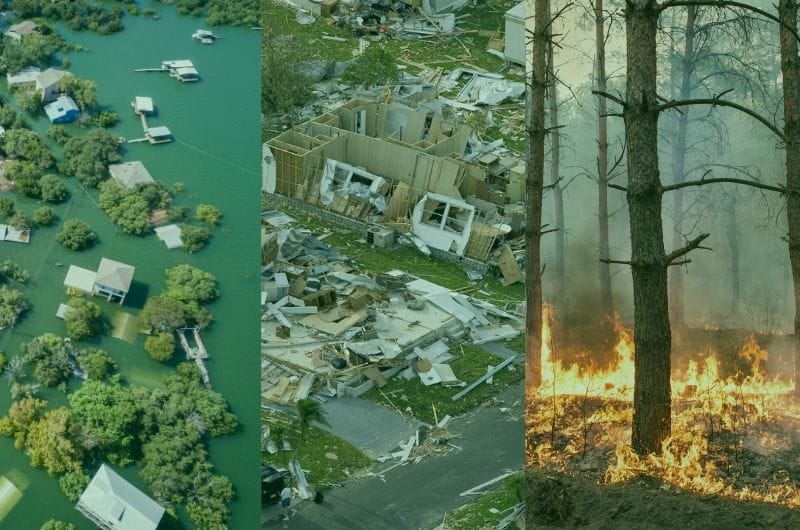
In 2021 the value of the global insurance industry was estimated to have reached USD 6 trillion in global premiums, USD 36 trillion in assets under management, and therefore represents a significant portion of global economic assets and liabilities. This is a staggering amount when you consider the humble beginnings of an industry that started out in London coffeehouses, where businessmen would meet to arrange insurance for ships and cargo heading overseas.
While the insurance industry has expanded far and wide since then, the core premise of measuring risk and developing pricing and solutions to cover the risk is as relevant to businesses and consumers today as it was to those early global traders back in the 1800s.
Climate Change Driving Higher Levels of Risk

More than ever, insurance companies are exposed to increasingly higher levels of risk, driven by increasing and intensifying climate change events, such as flooding, stronger hurricanes, and wildfires, collectively referred to as physical risks. 2021 provided a rich array of the possible impacts from these extreme weather events. From the record high temperatures and wildfires in the northwest USA and in southern Europe, to the devastating floods in Germany or the terrifying scenes of flooded subways in China, to the wildfires in Siberia and the accelerated melt of the permafrost.

Alarm Bells Ringing …….. But Glimmers Of Hope Remain
For some time now, scientists have been sounding the alarm that we would be witness to a significant increase in extreme weather events. However, the latest IPCC Report has provided some sobering reading to an already dark and gloomy world. The report reinforces that we are already seeing impacts more severe than were anticipated. It also highlights the urgent need for rapid investment in climate adaptation and resilience to address the worst current and near-future impacts of climate change. The report does provide a glimmer of hope – that we still have a chance to prevent much more severe impacts of climate change by reducing greenhouse gas emissions (by 50% by 2030) and scaling up adaptation resilience.
We still have a chance to prevent the much more severe impacts of climate change but the window to act is closing fast. And so, clearer than ever is that we need to do more, faster.
Managing ESG Risks in Insurance

The industry has had to deal with numerous significant challenges over the years, and the latest one is managing ESG and climate-related risks. The good news is that when it comes to ESG risk, the sector is ahead of the curve in incorporating ESG measurement into their overall risk management practice. However, as the old adage goes, the devil is in the detail. And measuring the impact of climate change, which has been more rapid, devastating and all-encompassing than anyone could have imagined, is notoriously difficult. Difficult, but not impossible.
To guide these efforts, the Financial Stability Board (FSB) created the Task Force on Climate-related Financial Disclosures (TCFD) to improve and increase reporting of climate-related financial information focusing on the four key financial sectors: asset management, asset owners, banks and insurance.
Similar to other sectors in the finance industry, insurers can and do play a significant role in addressing the climate change challenge. They are in a unique position to control and influence their client companies, particularly relevant given that ESG and climate-related risks are increasingly material for insurers given the increase in losses. Typically, insurers and their clients face a range of climate-related risks and opportunities which fall into three categories:
- Physical risks related to the increase in frequency and intensity of extreme weather events.
- Transition risks driven by the move towards a decarbonized economy and related fundamental changes in the underlying economy.
- Litigation risks pertaining to climate change.
What Actions Can Insurers Take?
Understand underlying exposures across their client base
Insurers need full visibility of their underlying exposures to physical, transitional, and litigation risks across their client base. This can often be an arduous and time-consuming task but very necessary to ensure complete visibility of ESG and climate-related risks and exposures.
Critically examine underlying client exposures
Once complete visibility of underlying exposures is achieved, insurers can make more informed decisions as to the risks they are prepared to accept. For some insurers, being exposed to certain industries raises the question as to whether it is in their interests to remain in these industries.
These are typically those industries driving and exacerbating climate change (GHG sensitive industries such as coal, oil & gas, chemicals, and related industries). This exercise can also identify opportunities to identify clients in lower-risk industries. For example, providing coverage for clean-green energy sources naturally involves less risk for an insurance seller as there is no fear of massive oil spills, explosions, and other inherent dangers.
Understand the ESG or climate-related risks
Undertaking an ESG Risk Assessment or Initial Evaluation often helps identify ESG or climate-related risks and opportunities and can provide an organization with a roadmap for how to navigate the ESG or climate-related risk landscape.
Pursue Opportunities to Enhance Underwriting Decisions
Insurers can gain a competitive advantage by ensuring their existing and prospective clients undertake such assessments or evaluations. This helps the underwriter make more informed and therefore better decisions.
Concurrently, it provides the client or prospect organization with a roadmap for how to address the ESG or climate-related risk landscape.
Adopting a robust ESG Risk Framework
In addition to considering implementing ESG Risk Assessments or Initial Evaluations, organizations can consider adopting prudent risk management processes that follow established guidelines.
Whether such risk management processes include TCFD or COSO or any other risk framework, they will most likely result in improved risk governance, and more finely tuned ESG and climate-related strategies which in turn will lead to better underwriting outcomes, benefitting both the underwriter and the client.
Application of the TCFD Framework in Insurance
TCFD follows an established and well-considered approach across its key dimensions of consideration – Governance, Strategy, Risk Management and Metrics & Targets. Similar to other sectors in the Finance Industry, it provides tailoring for the Insurance sector which can include:
Area
Things To Consider
Climate Risk Governance
Increase climate awareness and education throughout the organization (board, executive team, management team, customers)
Ensure governance is in place to manage climate-related risks
Climate Risk Strategy
Develop a simplified roadmap that focuses only on the material issues impacting the portfolio company
Describe the impact of climate-related risks and opportunities on the organization’s businesses, strategy, and financial planning.
Describe the resilience of the organization’s strategy, taking into consideration different climate-related scenarios, including a 2°C or lower scenario.
Climate Risk Management
Ensure climate risk is integral to investment processes
For holdings, provide support structure:
- Consider climate risks that may affect valuations based on material climate indicators
- If/when material risks are identified, define climate targets at a portfolio level.
Describe the organization’s processes for identifying and assessing climate-related risks.
Describe the organization’s processes for managing climate-related risks.
Climate Risk
Metrics & Targets
Disclose the metrics used by the organization to assess climate-related risks and opportunities in line with its strategy and risk management process.
Identifying ESG and climate-related risks in both your and your clients’ organization provides enhanced data, improves underwriting decisions and puts you at a competitive advantage, freeing up time to focus on the day job of growing your business. Whether you pursue an initial ESG or climate risk assessment or evaluation, or a more in-depth framework review, your business will reap the benefits and thrive.